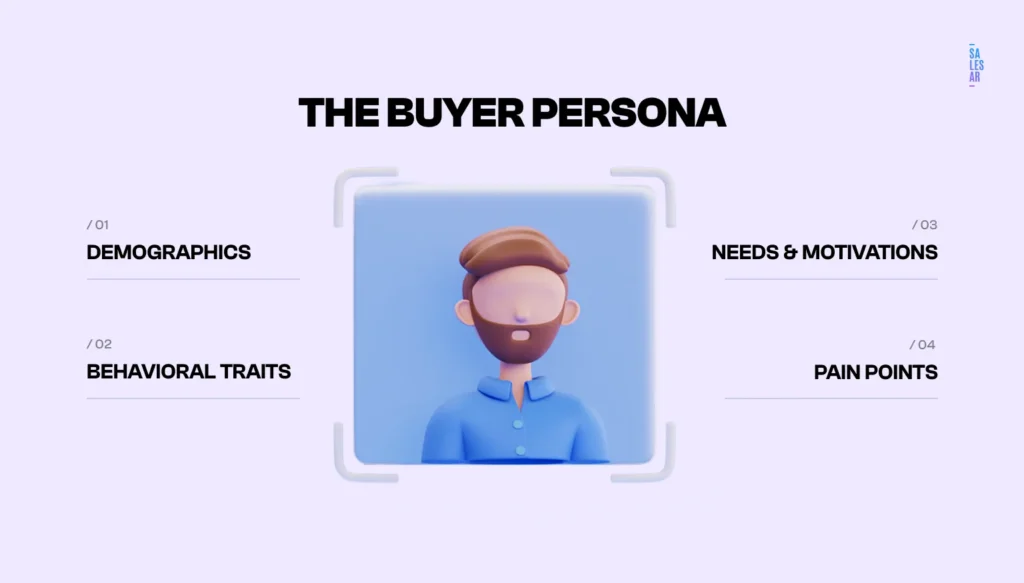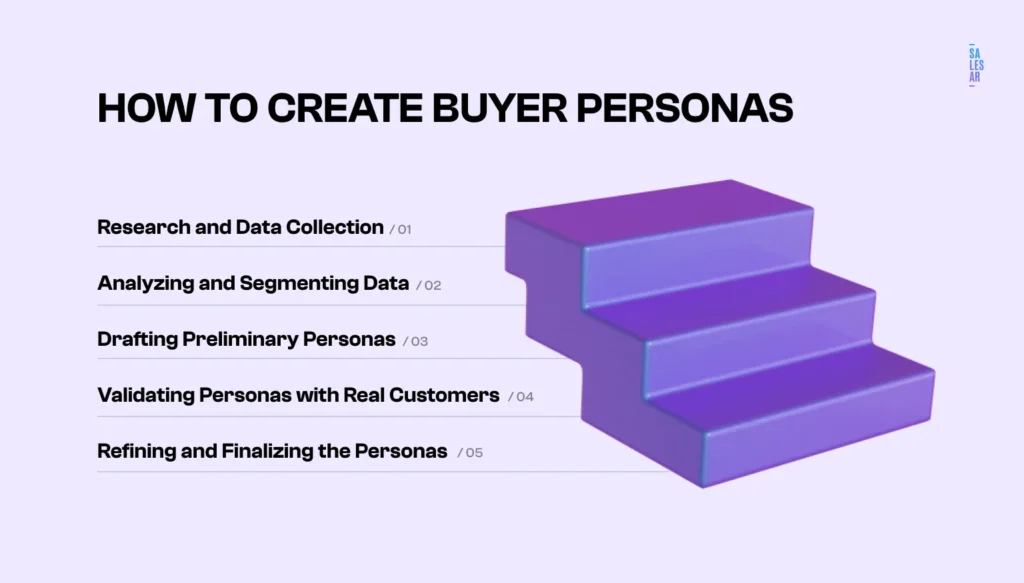In 2023, understanding your audience has never been more critical. Businesses, regardless of size or industry, are vying for a share of consumers’ attention. This insane level of competition forces industry veterans to consistently stay on top of their game, and why newcomers to the field find themselves asking questions like “What are buyer personas?” and “How do I create them?”
The key to understanding a buyer’s persona lies in the intimate understanding of who those consumers truly are. Buyer persona research has revealed that it’s essential to craft detailed representations of your audience segments.
This article will explore the world of buyer personas, explaining their importance, detailing how to build customer personas, and illustrating how they can drive tangible results for businesses. Through this guide, we aim to empower you with the tools and insights needed to craft personas that resonate, ensuring that your marketing strategies are not only informed but also effective.
The Importance of the Buyer Persona to Your Business
A business’s success hinges on how well it understands its customers. This understanding is facilitated through the profound evolution of marketing strategies in the 21st century, moving from one-size-fits-all campaigns to bespoke, tailored approaches utilizing the marketing buyer persona.
Personalization in Marketing
As we venture further into the era of digital personalization, the shift from generic to personalized marketing strategies becomes increasingly pronounced. Modern consumers don’t just appreciate personal touches, they demand them. Brands that can pinpoint and cater to individual needs and preferences create experiences that resonate more deeply, leading to stronger customer connections.
Impact on ROI
Businesses today understand that profiling buyer personas boosts their marketing efficacy. Campaigns informed by an ideal buyer persona optimize ad spend and yield higher conversion rates. By channeling efforts toward genuinely interested consumers, businesses not only conserve resources but also amplify their Return on Investment (ROI). Studies have indicated that companies utilizing well-crafted buyer personas can enhance their email campaign open rate and click-through rate by up to 2-5 times.
Defining the Buyer Persona
Understanding the buyer persona is paramount to any marketing success. At its core, it’s a compass guiding businesses toward their ideal customer avatar. It’s a mosaic of real data, market research, and a touch of educated speculation, offering insights into the ideal customer’s world.

Benefits
Here’s the real question – why create buyer personas? Businesses, from startups to established giants, swear by them for various reasons. These include precision in targeting, efficiency in marketing spend, and enhanced engagement with the audience.
- Precision. Products, services, and content aren’t developed in the dark, they’re tailored to meet the exact needs, desires, and pain points of specific customer segments.
- Efficiency. With a clear persona, ad dollars and marketing efforts are laser-focused, ensuring maximum impact.
- Engagement. The modern customer values connection. Personalized content, informed by specific personas, can bridge the gap between businesses and their audience, fostering stronger bonds.
Key Components
While each persona is as unique as the individual it represents, there are foundational elements that remain consistent.
- Demographics. This includes vital statistics like age, gender, location, income, and more.
- Behavioral Traits. These dig deeper into the ‘how’ and ‘why’ of customer interactions, such as purchasing habits and brand preferences.
- Needs & Motivations. This focuses on the driving forces behind their actions.
- Pain Points. These are challenges or problems that, when addressed, make your product or service invaluable to the consumer.
Types of Buyer Personas
Recognizing the varied facets of buyer personas equips businesses to cater to diverse audience segments more effectively. Building buyer personas can be approached in several ways: demographic-based, behavior-based, and goal-oriented. Often, the most effective strategies combine elements from all three types.
- Demographic-based. These personas are constructed around core demographic markers. For instance, a company specializing in luxury travel might target ‘Affluent couples aged 40-60, who prefer exotic destinations and five-star experiences.’
- Behavior-based. Behavioral personas offer insights into customer actions. For a music streaming platform, users might be segmented based on their genre preferences or playlist creation habits, like ‘Indie music lovers who curate and share playlists monthly.’
- Goal-oriented. These delve into customers’ deeper motivations. Consider an app focused on meditation and mental wellness. A persona here could be ‘Stressed urban professionals aged 28-40 seeking techniques for relaxation and mindfulness amidst their hectic schedules.’
It’s essential to note that often, the most effective strategies combine elements from all three types, painting a holistic picture of the prospective customer, and ensuring every marketing message hits home.
B2C vs B2B Buyer Personas
Buyer personas are invaluable tools for any marketing strategy, regardless of whether you’re targeting individual consumers (B2C) or businesses (B2B). However, it’s essential to understand the distinctions between B2C and B2B buyer personas.
Complexity and Decision-Making Process
B2C: Typically, the decision-making process for individual consumers is shorter and less complex. Decisions may be driven by personal preferences, emotions, immediate needs, or price.
B2B: The decision-making process in B2B scenarios often involves multiple stakeholders, each with their own concerns and criteria. It’s more prolonged, requires a more logical and ROI-driven approach, and may entail contractual agreements.
Motivation and Pain Points
B2C: Emotional drivers, lifestyle choices, and individual needs play a significant role. Pain points might include product affordability, brand reputation, or product functionality.
B2B: Decisions are more strategic and are typically driven by factors like operational efficiency, profitability, and long-term partnerships. Pain points often revolve around integration challenges, vendor reliability, and total cost of ownership.
Information Sources and Research
B2C: Consumers might look at online reviews, seek recommendations from friends or family, or be influenced by advertisements and influencers.
B2B: Businesses lean heavily on industry-specific publications, peer recommendations, case studies, whitepapers, and detailed product demos.
Personalization and Engagement
B2C: Personalization in B2C markets might revolve around individual user behavior, preferences, or past purchase history. Marketing messages can be more emotive and aspirational.
B2B: Personalization in B2B scenarios focuses on understanding the business’s unique challenges, industry, and goals. Messaging is more solution-driven, focusing on value propositions and benefits to the organization.
Duration of Relationship
B2C: While brand loyalty is a goal, the B2C sales cycle is generally shorter, and the relationship may or may not be long-term, depending on the product or service.
B2B: Given the investment in time and resources, B2B relationships are often long-term. Post-purchase engagement is crucial, with an emphasis on customer support, training, and potential upselling or cross-selling opportunities.
What Goes into Persona Development?
Creating a buyer persona isn’t about mere guesswork, it’s a structured process combining data analytics, market insights, and direct customer interactions. Before forming a persona, it’s essential to gather data from various sources like surveys, website analytics, sales team insights, market research, and customer interviews.
- Surveys – Use customer surveys to glean information about their habits, preferences, and pain points.
- Website Analytics – Platforms like Google Analytics can provide demographic data, user behavior, and more.
- Sales Team Insights – Frontline salespeople interact directly with customers and can offer invaluable feedback.
- Market Research – This process involves understanding wider industry trends and the demands of potential customers.
- Customer Interviews – One-on-one interviews give depth to your data, turning numbers into narratives. Direct feedback helps in understanding motivations, challenges, and experiences with your products or services.
How to Create Buyer Personas in 5 Simple Steps
Creating your ideal customer avatar, or buyer persona, is a strategic initiative. Begin with research and data collection, followed by analyzing and segmenting this data. Draft preliminary personas and then validate them with real customers or teams. Lastly, refine and finalize these personas, ensuring they are dynamic and aligned with market conditions and customer preferences.
- Research and Data Collection – Start by accumulating data from the sources mentioned earlier, ensuring a broad and varied data set to work from.
- Analyzing and Segmenting Data – Segment the collected data into categories. You might find patterns, like a group of users interested in eco-friendly products or those driven by cost-effectiveness.
- Drafting Preliminary Personas – Using segmented data, draft initial personas. Remember, these are fluid and will evolve as you gather more information.
- Validating Personas with Real Customers – Once you’ve drafted your personas, validate them. Please share them with your sales and support teams, or even directly with trusted customers, to gather feedback.
- Refining and Finalizing the Personas – Based on feedback and ongoing data collection, refine your personas. Ensure they’re dynamic, revisiting and tweaking them periodically as market conditions and customer preferences change.

Examples of Buyer Persona
Understanding buyer personas goes beyond just theoretical knowledge. Concrete examples serve as beneficial illustrations, providing a more tangible sense of these constructs. Here are two detailed B2B buyer persona examples that paint a clearer picture:
IT Jack
Demographics:
- Age: 42 years old
- Gender: Male
- Position: Chief Information Officer (CIO) of a mid-sized enterprise
- Education: Master’s in Information Systems
Behavioral Traits:
- Research Methods: Frequently attends tech conferences, subscribes to IT journals, and relies heavily on peer recommendations.
- Decision Drivers: Look for tech solutions that have been tried and tested in the industry and offer a good ROI.
Needs & Motivations:
- Scalability: Requires IT solutions that can grow with the company and won’t become obsolete quickly.
- Security: As cyber threats become more sophisticated, he needs products that promise and deliver top-notch security.
Pain Points:
- Integration: Struggles with products that don’t integrate well with existing systems.
- Vendor Support: Has faced challenges in the past with vendors who don’t offer robust post-purchase support.
Enterprise Emma
Demographics:
- Age: 37 years old
- Gender: Female
- Position: Head of Procurement for a multinational corporation
- Education: MBA in Supply Chain Management
Behavioral Traits:
- Evaluation Process: Engages in rigorous vendor evaluations, often involving RFPs (Request For Proposals) and multiple rounds of negotiations.
- Trust Indicators: Place a high value on vendor testimonials, case studies, and track records in the industry.
Needs & Motivations:
- Efficiency: Seeks solutions that will streamline processes, reduce costs, and enhance productivity.
- Compliance: In her role, regulatory compliance is non-negotiable. She needs vendors who understand this and can adhere to industry-specific regulations.
Pain Points:
- Communication: Finds it challenging when vendors aren’t transparent or proactive in their communication.
- Long-Term Value: Is wary of vendors who offer short-term discounts but don’t provide long-term value or partnership potential.
Buyer Persona Development
Understanding the foundation and significance of buyer personas is paramount. Let’s now explore the intricate details of how to develop, implement, and maintain them efficiently.
Stakeholder Involvement
Ever wondered who creates your buyer personas? The creation of a buyer persona isn’t simply relegated to the marketing team. It’s a holistic approach that benefits from the insights of multiple departments. By engaging teams across your organization, particularly sales and customer support, you gain first-hand knowledge and experiences that these teams have had with customers.
These insights can provide nuances about customer preferences, pain points, and needs that may not be evident through data alone. Collaboration not only brings in diverse perspectives but also ensures company-wide alignment on who the target customers are.
Refining Over Time
Like all strategic initiatives, buyer personas aren’t static. Their relevance can diminish if they’re not attuned to the ever-changing market conditions and shifts in consumer behaviors. As businesses expand, diversify, or pivot, and as markets undergo transformations, it’s crucial that buyer personas are revisited and adjusted accordingly.
Establishing periodic reviews, whether bi-annually, annually, or even quarterly for fast-evolving sectors, guarantees that your personas remain fresh and pertinent. This iterative process keeps teams aligned and focused on the current customer landscape.
Using Technology
Technology can be a game-changer in personal development. There are a plethora of tools available that simplify and streamline the process. For instance, platforms like HubSpot’s Make My Persona offer guided workflows that help businesses construct detailed and accurate buyer personas. These tools often come with intuitive interfaces that prompt users for relevant information, ensuring you cover all essential aspects. Moreover, using analytics to create buyer personas can be especially insightful.
Incorporating Feedback
The development of a buyer persona should be an ongoing conversation. One of the richest sources of information when shaping or refining these personas is feedback. Always maintain open channels of communication with both internal teams and external customers. The perspectives and experiences of those interacting directly with your products or services can provide invaluable insights. Encourage feedback sessions, conduct surveys, or even host focus groups.
By embedding a culture of continuous learning and being receptive to feedback, businesses can ensure that their buyer personas are not just theoretical constructs but dynamic tools that genuinely resonate with the target audience.
Create Your Own Buyer Personas
Ready to create your persona? Following these steps is the best way to create a buyer persona:
- Set Clear Objectives – Understand why you’re creating a persona. Is it to drive sales, improve product development, or refine content strategy?
- Gather Real Data – Relying solely on assumptions is a pitfall. Use surveys, interviews, and analytics tools.
- Utilize Templates – Start with a foundational marketing avatar template or a B2B buyer persona template and customize it as per your needs.
- Draft Detailed Narratives – To learn how to create detailed buyer personas, go beyond mere points and craft detailed narratives. Instead of just stating “Prefers online shopping,” expand with “Prefers online shopping due to the convenience it offers amidst her busy schedule.”
- Seek Validation – Once your personas are drafted, validate them with real-world tests. Run specific campaigns targeting your personas and assess the results.
- Iterate – As previously emphasized, persona creation isn’t a one-time job. Regularly update them based on changing market scenarios, product evolution, and customer feedback.
Remember, the more detailed and accurate your persona, the more effective it will be as a guiding tool in your marketing endeavors.
Conclusion
Crafting a detailed and accurate buyer persona is not just an academic exercise – it’s a strategic necessity. In the competitive landscape of 2023, where consumer behaviors, preferences, and demands shift rapidly, businesses that stay attuned to their core audience will thrive. These personas act as a beacon, guiding product development, marketing campaigns, content creation, and more.
By investing time and resources into understanding and regularly refining these personas, businesses position themselves to build deeper, more meaningful connections with their audience. In this age of digital personalization, remember – it’s not about reaching more people, it’s about reaching the right people in the right way.
FAQ
What is a buyer persona and why is it essential for my business in 2023?
A buyer persona is a detailed representation of your ideal customer, based on real data, market research, and some level of educated speculation. In the competitive landscape of 2023, it helps businesses understand and cater to the specific needs, behaviors, and pain points of their audience, ensuring that marketing strategies, product developments, and content are tailored and effective.
How can I validate the accuracy of my buyer persona?
Validation is a crucial step in the process. Once you’ve drafted your buyer persona, share it with teams that interact with customers, like sales and support. They can provide insights from their firsthand experiences. Moreover, you can test your personas in real-world scenarios – run targeted campaigns, and assess the results. Feedback from trusted customers can also serve as valuable validation.
Are buyer personas static or do they evolve over time?
Buyer personas are dynamic and should evolve over time. As market conditions, customer preferences, and business products/services change, it’s essential to revisit and refine your personas. Setting periodic reviews, perhaps bi-annually or annually, ensures they remain relevant and accurate.
Do I need to use a template when creating my buyer persona?
While using a template isn’t mandatory, it can provide a structured starting point, ensuring you don’t miss out on key details. Templates act as a foundational blueprint that you can then customize based on your unique business needs and audience insights. Different templates might offer varied perspectives, and you can choose one that aligns best with your objectives.




